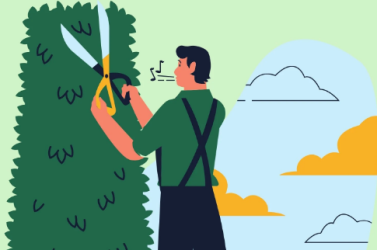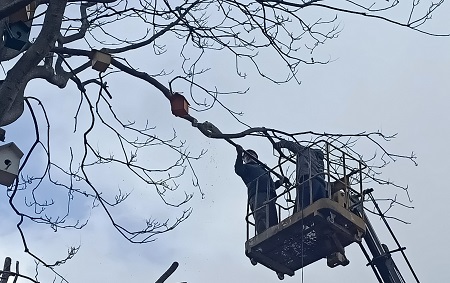In Canada, the process of obtaining permission to cut down trees can vary depending on the location, purpose, and the type of land where you want to harvest trees. Here’s how you can get permission to cut trees in different regions of Canada:
Alberta: For personal use tree cutting in designated Crown land areas in Alberta, you can get a Personal Use Forest Products Permit or a Local Timber Permit. More information can be found on the Alberta government website.
Mississauga: If you need to remove or injure trees in Mississauga, you should contact the City of Mississauga’s forestry and environment department for information and permits.
British Columbia: In British Columbia, the Inspector of Mines has the authority to issue free use permits for clearing trees associated with exploration and mining activities.

Ottawa: If you are wondering whether you need permission to cut down a tree on your own property in Ottawa, you may need to obtain a City of Ottawa tree removal permit. Contact the City of Ottawa for specific guidelines and permits.
Surrey: In Surrey, the removal or cutting of trees is regulated by the Tree Protection Bylaw. Permits are required, and trees can only be removed if they meet specific requirements. You should contact the City of Surrey for information and permits.
Make sure to check with local authorities and relevant websites for the most up-to-date and specific information on tree cutting permissions in your area. Always follow the local regulations and guidelines to ensure responsible and legal tree harvesting.
In what season is tree pruning done in Canada?
In Canada, tree pruning is typically done during the winter, specifically during the dormant phases of the trees. Winter pruning is the preferred time because it allows for optimal plant health and reduces the risk of spreading diseases. Pruning during late fall and early winter is common, usually from December through to mid-February. However, there are some regional variations:
- Ontario: Most pruning is done in late fall and early winter, which aligns with the dormant phase of the trees in this region.
- Alberta: The ideal time for pruning trees in Alberta is from March to mid-April, waiting until the worst of winter is over, typically around the end of winter.
- Toronto: Fall tree pruning is not recommended, as it’s best to avoid pruning trees with leaves still present during this season. Winter is a more suitable time for pruning in Toronto.
Overall, while there may be regional variations, the general guideline for tree pruning in Canada is during the winter months when trees are dormant.
When to prune fruit trees in Canada?
In Canada, the timing for pruning fruit trees can vary depending on the specific region and climate. Here are some general guidelines for when to prune fruit trees in Canada:
- Late Winter to Early Spring: In many parts of Canada, late winter into early spring is considered the best time to prune fruit trees. This period typically falls between late February and early April. Pruning during this time allows the tree to benefit from the upcoming growing season and reduces the risk of winter damage.
- Before Bud Break: It’s advisable to prune fruit trees before the buds begin to open. This usually means pruning before the tree enters the active growing phase in early spring.
- Exceptions: There may be variations depending on the type of fruit tree and the specific goals of pruning. For example, apple trees are often pruned in late winter to early spring to maintain their shape and encourage fruit production, while peach trees are pruned later in spring to avoid cold injury.
Please consider the local climate and the specific needs of your fruit trees when determining the exact timing for pruning. For more region-specific advice, consult local horticultural resources or agricultural extension services.
When should you trim trees in Canada?
The best time to trim or prune trees in Canada depends on several factors, including the type of tree, the specific climate of your region within Canada, and the purpose of the pruning. However, here are some general guidelines to consider:
- Late Winter to Early Spring (Dormant Season):
- For most deciduous trees, it’s often recommended to prune during late winter or early spring when the tree is still dormant. This is before new growth begins, and it’s easier to see the tree’s structure.
- Pruning during this time helps stimulate new growth in the spring and allows the tree to heal before the growing season.
- Summer:
- If you’re primarily concerned with removing dead or diseased branches, you can do so in the summer months. It’s easier to identify and remove these issues when leaves are present on the tree.
- Be cautious about pruning too late into the summer, as it can stress the tree as it prepares for the winter.
- Avoid Late Fall:
- Avoid pruning in late fall as the tree may not have enough time to heal properly before winter, leaving it vulnerable to disease and winter damage.
- Evergreen Trees:
- Pruning of evergreen trees, like pine or spruce, is best done in late winter to early spring as well.
- Fruit Trees:
- Fruit trees have their own specific pruning requirements. Generally, pruning should be done during late winter or early spring, but it can also depend on the specific type of fruit tree and your goals for pruning (e.g., shaping, thinning, rejuvenation).
It’s important to note that the specific timing for tree pruning may vary depending on your local climate and the tree species. Before pruning, consider consulting with a local arborist or tree care professional who is knowledgeable about the trees in your area. They can provide guidance on the best time and techniques for pruning to ensure the health and vitality of your trees. Additionally, always follow any local regulations or bylaws regarding tree pruning and removal, as they can vary from place to place.
Tree pruning prices in Canada
Tree pruning prices in Canada vary depending on factors such as location, tree size, and the extent of work required. Here’s a general overview:

- Toronto, Ontario:
- The cost for pruning a tree in Toronto can range from $250 to $600 for a mild prune (less than 5% of canopy).
- Vancouver, British Columbia:
- The cost of pruning or trimming trees in Vancouver varies based on the type of trees and their sizes. You may find more specific pricing information from local tree service providers.
- Montreal, Quebec:
- Specific pricing details for tree pruning in Montreal are not provided in the search results, but you can obtain this information by contacting local tree care companies.
- Halifax, Nova Scotia:
- Tree trimming services in Canada can range from about $80 to $500 in the Halifax and surrounding towns, with an average cost of around $290.
- General Pricing:
- Tree pruning costs can vary widely based on the size and height of the tree. For larger trees over 60 feet tall, the cost may range from $400 to $1,800. Tree trimming prices can also be quoted on an hourly basis, typically ranging from $50 to $125 per hour.
For accurate and up-to-date pricing in your specific area, it’s advisable to contact local tree service providers for quotes. Prices may further depend on factors like the condition of the tree, accessibility, and any additional services required. Tree pruning in Canada >>
Is it possible to get permission to cut trees in Canada?
In Canada, the rules and regulations regarding tree cutting vary depending on the location and purpose. Here’s a general overview:
Personal Use Forest Products Permit: In Alberta, individuals can obtain a Personal Use Forest Products Permit or a Local Timber Permit to harvest trees in designated Crown land areas for personal use. You can find more information on this at the Alberta government’s official website.
Tree Cutting on Private Property: If you want to cut down a tree on your own property, the regulations may differ from one municipality to another. In some cases, you may need permission or a permit, while in others, it may be subject to local bylaws. It’s essential to check with your local authorities or city regulations regarding tree removal on private property.
Special Permits in Certain Cities: In some cities like Vancouver, special permits may be required to cut down healthy trees on your property. This often involves getting approval from an independent arborist.
Free Use Permits: In British Columbia, you can obtain a Free Use Permit for minor volumes of Crown timber for personal purposes, such as firewood collection and Christmas tree cutting.
To ensure you are in compliance with local regulations, it’s advisable to contact your local government or municipality for specific information about tree cutting permissions in your area. Where to get a tree felling permit in Canada? >>